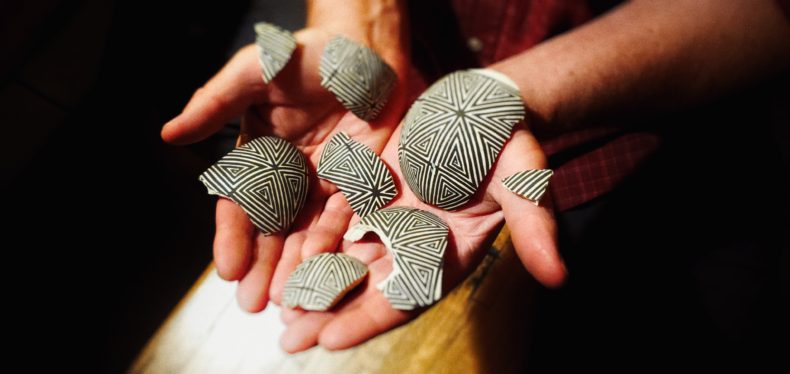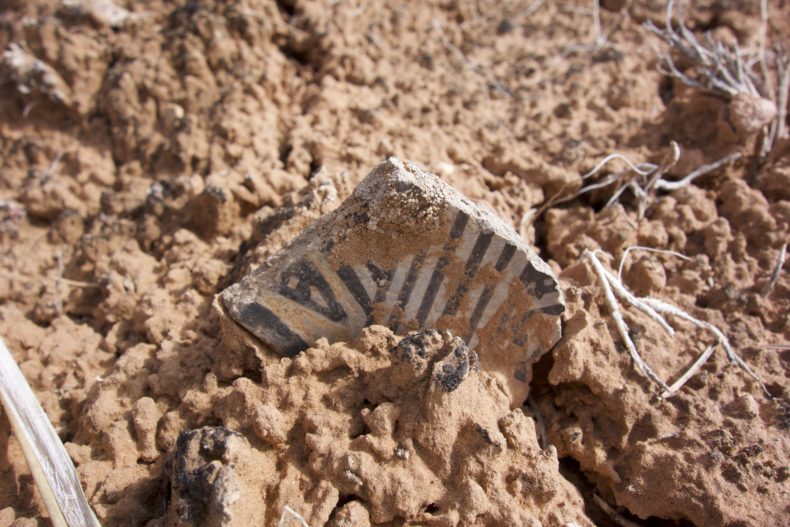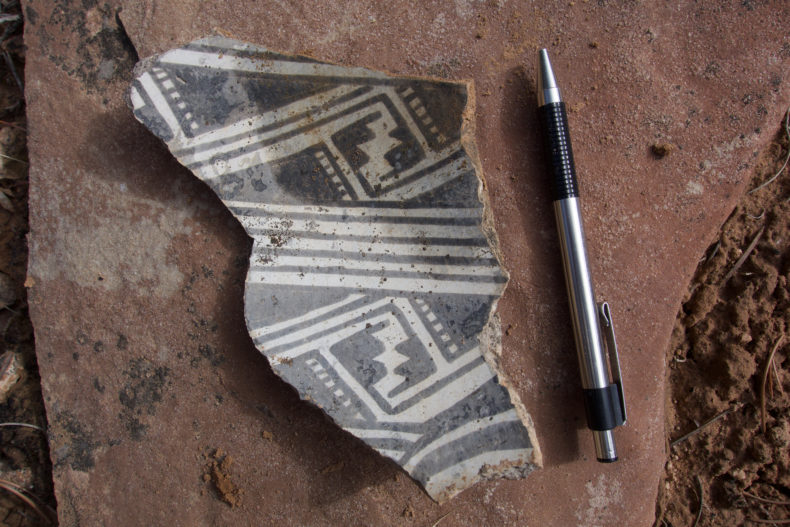
I broke a pot the other day, not just any pot but a ceramic Acoma vessel I inherited after my father died decades ago. I snatched something from the shelf, barely tapping the little seed jar, its mouth big enough for a finger, maybe two. It barely rocked one way and then the other, energy transferring, going off balance. Out of the corner of my eye, I saw something midair, wondered for half a second what I’d set free. Then, a singular pop on the floor. I knew.
The term is ‘potsherd’. Not shard. It is its own category of broken thing.
I’ve been looking at potsherds for a long time, parts of the desert strewn and sprinkled with pieces of broken jars, bowls, and cups from the early millennia AD, Pueblo ancestry. A well of generations passed vessels back and forth, water carried, food served. Trade routes moved ceramics through passes and along rivers, northern Mexican wares found in Utah, Colorado wares found in southern Arizona. Some places are carpeted in broken pieces. Walking onto a ruined pueblo at the edge of the Hopi reservation, there’s hardly a spot of soil. The ground is made of them.

The pieces on our hard, concrete floor went all directions as if from a small, exploded sun. The potter’s name is painted in black on the bottom, M. Garcia, and the word Acoma, which is a pueblo in northwest New Mexico, a cliff-sided mesa where people have been living for a thousand years or more. These are the people who last month celebrated the removal of a statue of Don Juan de Oñate, a conquistador leader who gruesomely ordered that the left foot of every Acoma boy and man and grandfather be cut off. All around the Acoma mesa for hundreds of miles are sites of broken pottery, evidence of longevity and continuity, of survival. I don’t know the date of this one, figuring early 1990s when my dad was purchasing pottery from dealers in his home state of New Mexico. Bone white clay painted with intricate black geometry, it would have fit in your palm, an elegant egg of a jar, my favorite of all of his.
You look at the ground and know where you are, when you are. Early wares, 400 AD, have delicately painted spiderweb lines, and older wares, 1200 AD, have bold, thick lines and tick marks added to the rims. Rim styles of Mesa Verde bowls will tell you what decade they were manufactured. Northern Arizona and southern Utah are ripe with red wares, the rest of the Four Corners black and white, polychromes a couple hundred miles south in the Mogollon Highlands, and buff-colored pots with birds and dancers painted in red in the Phoenix Basin.
People like to pick them up and take them home. Some are small as buttons, some a quarter of a broken bowl with insides painted in spirals and interlocked teeth. I’ve seen places lousy with potsherds turned bare in a decade or two. It’s like sweeping ancestry off the land. It seems innocent enough. Just one piece, maybe two. The stark black lines on white-slipped clay are like a prize. You feel like you really discovered something. You want it as a reminder. Don’t do it.

In a thousand years, they’d still be here, curated by aridity. Every rainstorm and snowmelt brings up a new but finite crop. People of Pueblo ancestry — Acoma, Tewa, Zuni, Hopi, etc. — know where their clans have been. It is no random thing to find masses of potsherds. They are markers. Some sites are known as ‘pot drops’ where hundreds, even thousands, of vessels were intentionally smashed, the ground a maze of intricate designs. You’ll find them in trash middens piled in front of ancient villages and households. The people had a different relationship with their refuse. Bodies and offerings were lovingly buried in middens. You find coils from turkey feather blankets and bits of braided twine. Potsherds were dumped across middens like casting bathwater. People migrated away from sites and returned several centuries later, setting up shop again in ancestral villages where I imagine them walking to their old, masonry ruins, scanning the ground, and saying, this is our place. One site may be Zuni, another Hopi. One is Bear Clan, another Corn. They are bloodlines in place.
Pocketing potsherds is erasure. It is the worst of colonization, the taking of the land. If you believe the stealing has ended, it has not.
You’ll find potsherds in the field with drill holes, meaning a crack was repaired, drilled on either side and tied together to keep the break from spreading. Some vessels were heirlooms, cared for, mended through generations, but those, too, broke and went to the ground. When the family heard the pop, it might have been the same as me, a sharp blow of disappointment followed by a sense of continuity, a story set free.
Maybe the little jar wanted to say something. It had been a family ornament for long enough and was time to put its message to use. I thought of gluing it back together, but the deed is done.
I’ll carry these pieces to the garden. They’ll stay in the ground for who knows how long, a claim of a people. Someone with the right eye may find them and know the story, the Acoma potter, my Anglo dad, and me walking out the door with a handful of potsherds, dropping them to the ground like seeds.
Lead image: Jasper Childs
Other images: Craig Childs
Velcrose tabs, one side on the bottom of your pots, the other glued onto the shelf. …works during earthquakes too
Craig, shouldn’t you have left these shards on your floor for future generations?
Mike, for future generations to cut their feet on!
Craig Childs elaborates on this topic in:
“Finders Keepers” A Tale of Archaeological Plunder and Obsession (© 2010)
Nice piece. The article and the sherds.
A family member broke a modern era Tohono O’odham effigy pot I had purchased some years ago. It can be glued together, but I just put the pieces in a small display case and the display now fascinates my friends more than when the ceramic pot was whole
Is that your drawing of Raven chicks?
As an archaeologist I used to lead tours out to various archaeological sites. When people would question me about the collecting of souvenir sherds I would respond with something like: “Would you want someone to hand you the only copy in existence of a book to read after they had torn off pieces from some of the pages?”
The problem with using velcro or even museum clay to stabilize a pot on the shelf is that the stick’um leaves a mark. I have a couple of pots for which I used the museum clay and now regret it. I also have a pot from an estate sale on which a sticky little price sticker was placed; left a non-removable mark.